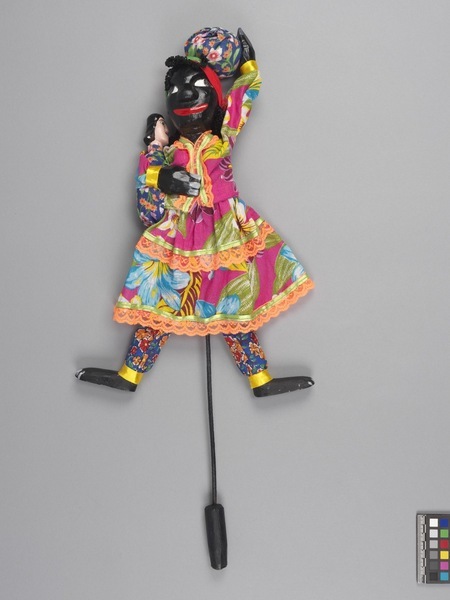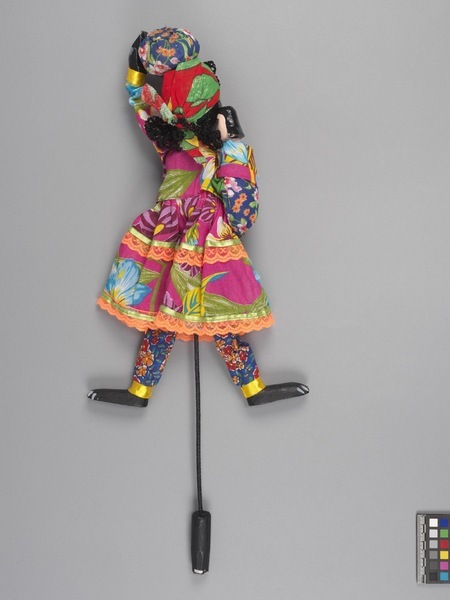Rod Puppet Item Number: 3352/12 from the MOA: University of British Columbia


Description
Mamulengo rod (stick) puppet of a woman and child character. Heads, hands and feet are carved from wood. The woman has black skin, large black almond-shaped eyes, red glossy lips, curly black hair made of fibre, and a green and red floral scarf on her head. She wears a long-sleeved brightly-coloured dress and blue floral pants, both with yellow cuffs. She is barefoot. The woman's left hand holds a bundle wrapped in blue floral fabric on her head. The woman is holding a baby in her right arm. The baby is pink-beige, with blue eyes, painted chin-length black hair, and is wrapped in blue floral fabric. Operated by a single rod attached to the body.
History Of Use
The puppet represents a character from a form of popular puppet theatre, found in northeastern Brazil, called mamulengo. This type of theatre is prevalent in disenfranchised communities with ancestral ties to colonized Indigenous peoples and uprooted, enslaved Africans. Mamulengo performances are entertaining events that can last all night long, with puppeteers (mamulengueiros) using 70 to 100 puppets in one staging. The stages are pop-up stands (empanadas), made of brightly coloured, floral-printed cloth. The shows consist of short sequences (passagens), or skits from popular stories that expose the inequalities and dramas of everyday life, profiling stock characters such as rich landowners and peasant labourers. The whole is spun together with humour, satire, lively music, and audience commentary.
Item History
- Made by Genilda Felix de (Maker) in Gloria do Goita, Pernambuco, Brazil during 2018
- Owned by Associacao Cultural de Amigos do Museu de Folclore Edison Carneiro before May 28, 2019
- Received from Associacao Cultural de Amigos do Museu de Folclore Edison Carneiro (Seller) and Museum of Anthropology Exhibitions Budget (Funding source) on May 28, 2019
What
Who
- Culture
- Brazilian
- Creator
- Genilda Felix de (Maker)
- Previous Owner
- Associacao Cultural de Amigos do Museu de Folclore Edison Carneiro
- Received from
- Associacao Cultural de Amigos do Museu de Folclore Edison Carneiro (Seller) and Museum of Anthropology Exhibitions Budget (Funding source)
Where
- Holding Institution
- MOA: University of British Columbia
- Made in
- Gloria do Goita, Pernambuco, Brazil
When
- Creation Date
- during 2018
- Ownership Date
- before May 28, 2019
- Acquisition Date
- on May 28, 2019
Other
- Condition
- good
- Accession Number
- 3352/0012